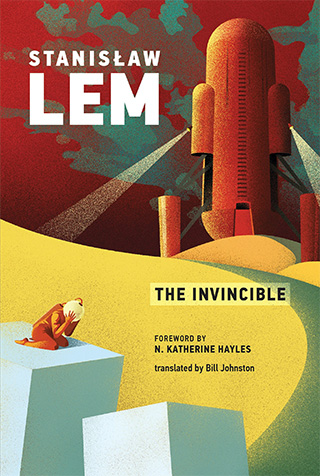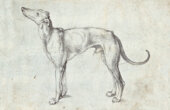Stanisław Lem's Prescient Vision of Artificial Life

In the grand tradition of H. G. Wells and Jules Verne, Stanisław Lem’s “The Invincible” tells the story of a space cruiser sent to an obscure planet to determine the fate of a sister spaceship whose communication with Earth has abruptly ceased. Landing on the planet Regis III, navigator Rohan and his crew discover a form of life that has apparently evolved from autonomous, self-replicating machines — perhaps the survivors of a “robot war.” Rohan and his men are forced to confront the classic quandary: What course of action can humanity take once it has reached the limits of its knowledge? In “The Invincible,” Lem has his characters confront the inexplicable and the bizarre: the problem that lies just beyond analytical reach.
The following is literary critic and theorist N. Katherine Hayles’ foreword to the 2020 edition of Lem’s classic novel, which was originally published in Polish in 1964.
Science fiction has famously predicted many of the important technologies of the 20th century: space travel, satellites, the atomic bomb, television, the internet, and virtual reality, to name a few. In “The Invincible,” Stanisław Lem predicts another: artificial life. Although speculations about self-reproducing artificial systems date from the 1940s, the scientific field received its name from Christopher Langton only in 1986, more than two decades after the original publication of “The Invincible” (1964). One of the central controversies in artificial life is whether evolutionary programs and devices are actually alive (the strong version), or whether they merely simulate life (the weak version). Researchers who follow the strong version argue that the processes embedded in software programs such as genetic algorithms are as “natural” as life itself; what is artificial is the medium in which these processes take place.

The issue prompted Robert Rosen, among others, to speculate about the essential characteristics of “life itself,” not only as it evolved on Earth in carbon-based life forms but also about the possibility of life-as-it-could-be in exoplanetary systems, arguing that silicon-based artificial life forms may provide insight into these theoretical speculations.
“The Invincible” presents a fascinating hybridization of these different views. Dr. Lauda’s hypothesis proposes that a space ship from the Lycran system landed on Regis III millions of years ago; while the biological visitors perished, the automata did not. There then followed an evolutionary struggle between the automata and the planet’s indigenous life forms, on the one hand, and between the different kinds of automata, on the other. Such a scenario requires that the “survive and reproduce” mandate that governs life on Earth could also operate on this planet. Lem minimally fulfills the requirement by postulating that the automata could manufacture themselves with modifications dictated by evolutionary processes. Clearly his interest is not in filling out how this might take place (John von Neumann, encountering a similar problem, imagined metal parts floating on a lake that could self-assemble). Rather, Lem’s focus is on envisioning an artificial life form that won the evolutionary competition on Regis III for profoundly different reasons than did Homo sapiens on Earth.
The effect is achieved by introducing a significant factor that has a monumental impact on evolutionary trajectories: rather than fulfilling their energy needs through ingesting food, the automata on Regis III evolve to use solar power. The smaller the artificial organism, the less energy it needs. Hence the evolutionary driver is toward smaller forms, which overcome not through superior intellect but through swarm intelligence. Lem added to this the ability of the swarm of “flies” to generate immensely powerful electromagnetic fields, which meant that the tiny automata are not only the evolutionary winners on their planet but a powerful force against the invading humans. Their tiny size notwithstanding, their awesome potential illuminates the profound ambiguity of the work’s title, which can be taken to refer either to the spaceship’s proud name or to the swarms of alien automata that threaten it.
“From a broader cosmic perspective, the best of human science, engineering, and weaponry may reveal humans to be completely out of our depth, mere kindergarteners bidding for a place in the universe’s adult civilizations.”
Contemporary research in artificial life has validated Lem’s insight that swarms of artificial beings require only a few simple rules to manifest complex behaviors and hence each member needs to carry only a little cognitive power onboard. Computer simulations that have accurately depicted swarm behaviors in fish, birds, bees, and other biota demonstrate that each individual responds only to the four or five closest to it, with rule sets that take up only a few lines of code. For example, a school of fish swimming to evade a predator is guided by the fish closest to the predator. The direction this most imperiled individual follows determines how the entire school will run as it flashes back and forth, a simple strategy that makes excellent sense, since the fish that has the most to lose will try hardest to escape. Although each fish’s behaviors are simple, the collective result nevertheless generates swarm intelligence of considerable complexity.
Decades before these ideas became disseminated within the scientific community, Lem intuited that different environmental constraints might lead to radically different evolutionary results in automata compared to biological life forms. Although on Earth the most intelligent species (i.e., humans) has tended to fare the best, their superior intelligence comes with considerable costs: a long period of maturation; a lot of resources invested in each individual; socialization patterns that emphasize pair bonding and community support; and a premium on individual achievement. But these are not cosmic universals, and different planetary histories might result in the triumph of very different kinds of qualities.
The contrasts between humans and the automata swarm are brought out most poignantly in the scene between Captain Horpach and First Officer Rohan, in which the captain delegates to Rohan the decision whether to put another crew member in grave danger to determine if the missing four men have indeed perished, as seems all but certain, or whether one or more might still be alive. The assumptions that make this gamble even remotely worth taking are revealing: human life is precious; human solidarity depends on the crew’s belief that everything possible will be done to save them if they are in peril; and every human is unique and therefore uniquely valuable. None of these, of course, holds true for the swarm, whose individual members are virtually identical to one another, with each tiny automaton easily replaced and therefore disposable. Consequently, none is valuable in itself; only the swarm has evolutionary survival value. The contest, then, is not only between different life forms but also between the different values that have resulted from the divergent evolutionary pathways of humans on Earth and the “flies” on this strange planet. As with “Solaris,” Lem suggests that assumptions born and bred of Earth may appear hopelessly provincial in light of human encounters with radically different life forms. From a broader cosmic perspective, the best of human science, engineering, and weaponry may reveal humans to be completely out of our depth, mere kindergarteners bidding for a place in the universe’s adult civilizations. The reduction of crew members to infancy when attacked by the “flies” may be a metaphor for this realization.
Of all the human characters, Rohan has the strongest claim to have encountered the planet on its own terms. He has traversed its terrain with his own feet; he has mixed his sweat with its crevices, valleys, and hills; he has breathed its native atmosphere into his lungs. The insight he gains from his heroic trek therefore commands our respect. When he concludes that “not everything everywhere is for us [humans],” we are right to hear in this pronouncement Lem’s own challenge to the anthropocentric assumptions that continue to dominate human ethical frameworks as well as human exploitations of planet Earth. As with the best science fiction, “The Invincible” has as much to teach us about our present situations as any futures we may face.
N. Katherine Hayles is Distinguished Research Professor of English at the University of California, Los Angeles.



